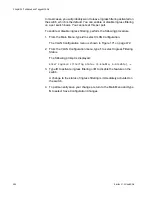
AT-S63 Management Software Menus User’s Guide
Section VI: Virtual LANs
483
4 - Tagged Ports
Use this selection to add or remove tagged ports from the VLAN. You
can specify the ports individually (e.g., 2,3,5), as a range (e.g., 7-9), or
both (e.g., 2,5,7-9).
When you add or remove tagged ports, observe the following
guidelines:
The new list of tagged ports will replace the existing tagged ports.
If the VLAN contains tagged ports and you want to remove them
all, enter 0 (zero) for this value.
5 - Untagged Ports
Use this selection to add or remove untagged ports from the VLAN.
You can specify the ports individually (e.g., 2,3,5), as a range (e.g., 7-
9), or both (e.g., 2,5,7-9).
When you add or remove untagged ports, observe the following
guidelines:
The new list of untagged ports will replace the existing untagged
ports.
If you want to remove all untagged ports from the VLAN, enter 0
(zero) for this value.
You cannot change the name of the Default_VLAN, nor can you
directly remove untagged ports from the Default_VLAN. Instead,
you must assign the port as an untagged port to another VLAN.
An untagged port removed from a VLAN is automatically returned to
the Default_VLAN as an untagged port.
Note
Selection 6, Protected Ports, should be left in the “No” default setting
when modifying a port-based or tagged VLAN. This option is
explained in Chapter 27, “Protected Ports VLANs” on page 521.
7. After making the desired changes, type
M
to select Modify VLAN.
The following message is displayed:
SUCCESS
Please make sure to manually update any static
multicast MAC address(es) entries for this VLAN.
Press any key to continue...
The VLAN has been modified and is now ready for network operations.
Any untagged ports removed from a VLAN are automatically returned
to the Default_VLAN as untagged ports.
Summary of Contents for AT-9400
Page 16: ...Figures 16 ...
Page 18: ...Tables 18 ...
Page 28: ...Preface 28 ...
Page 30: ...30 Section I Basic Operations ...
Page 60: ...Chapter 1 Basic Switch Parameters 60 Section I Basic Operations ...
Page 64: ...Chapter 2 Port Parameters 64 Section I Basic Operations Port Type The port type ...
Page 84: ...Chapter 2 Port Parameters 84 Section I Basic Operations ...
Page 124: ...Chapter 6 Static Port Trunks 124 Section I Basic Operations ...
Page 144: ...144 Section II Advanced Operations ...
Page 196: ...Chapter 10 File Downloads and Uploads 196 Section II Advanced Operations ...
Page 218: ...Chapter 11 Event Logs and the Syslog Client 218 Section II Advanced Operations ...
Page 242: ...Chapter 13 Access Control Lists 242 Section II Advanced Operations ...
Page 294: ...294 Section III IGMP Snooping MLD Snooping and RRP Snooping ...
Page 314: ...Chapter 19 MLD Snooping 314 Section III IGMP Snooping MLD Snooping and RRP Snooping ...
Page 318: ...318 Section IV SNMPv3 ...
Page 416: ...Chapter 21 SNMPv3 416 Section IV SNMPv3 ...
Page 418: ...418 Section V Spanning Tree Protocols ...
Page 470: ...470 Section VI Virtual LANs ...
Page 520: ...Chapter 26 Multiple VLAN Modes 520 Section VI Virtual LANs ...
Page 532: ...Chapter 27 Protected Ports VLANs 532 Section VI Virtual LANs ...
Page 546: ...546 Section VII Internet Protocol Routing ...
Page 560: ...560 Section VIII Port Security ...
Page 568: ...Chapter 30 MAC Address based Port Security 568 Section VIII Port Security ...
Page 586: ...Chapter 31 802 1x Port based Network Access Control 586 Section VIII Port Security ...
Page 588: ...588 Section IX Management Security ...
Page 610: ...Chapter 33 Encryption Keys 610 Section IX Management Security ...
Page 650: ...Chapter 36 TACACS and RADIUS Protocols 650 Section IX Management Security ...
Page 660: ...Chapter 37 Management Access Control List 660 Section IX Management Security ...
Page 668: ...Index 668 ...






























